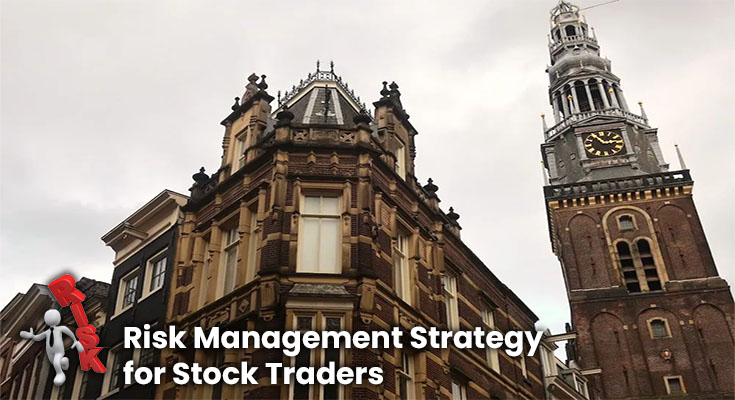Don’t over-monitor the market and your stop loss
The first risk management strategy for stock traders in the Netherlands is to limit losses, and it’s probably surprising that I didn’t start far more apparent advice such as: always set a stop loss when trading.
This mistake comes from every blog post or YouTube video about trading or investments, starting with advice on how important it is to have a stop loss in place.
I know it’s essential, but you’ll probably agree with me: setting a stop loss works only part of the time and can be highly emotionally draining because we constantly (and mostly subconsciously) monitor our trades and the market.
When we see signs of an adverse move, we tighten our stops, and sometimes we even exit positions too early because we want the pain to stop.
This is why I believe in a different approach: limiting losses and cutting losers short is an absolute necessity, but it has to be done in such a way that you minimize the emotional effects this process has on you. This can be achieved by having multiple rules for your exit strategy at any given time and not just one single rule that, if violated, will result in your immediate loss of capital.
When using stops, my favorite trading strategy is the Fibonacci retracement level + daily pivot point. It allows me to enter trades with very little market exposure yet provides an effective risk management tool while I’m waiting for the trade to play out (and also gives me some nice pips along the way).
Stop losses on every trade
The second risk management strategy for stock traders in the Netherlands is to stop losses on every trade. It may seem straightforward, but it’s incredible how many of us are trading without using stops or using them very severely by placing them at random entry points.
Even if you don’t believe in technical analysis, I will urge you to use a stop loss because it makes your life much more straightforward, especially when trading during news events or large market swings.
If your brokerage offers guaranteed stops (which some do), this eliminates any downside risk caused by slippage or gaps opening up against you, so there isn’t an excuse not to use them.
Balance your portfolio
The third risk management strategy for stock traders in the Netherlands is to have a well-balanced portfolio, which has been built from scratch after conducting a thorough fundamental analysis.
Some investors make the mistake of thinking that diversification doesn’t matter as long as you’re only trading one or two assets at a time, but that couldn’t be further from the truth because it puts them at risk of not being able to sleep well at night.
I believe there are several reasons for this.
Firstly, if you know nothing about how markets work, then chances are high you will overtrade, which means your emotions will always be tied to every trade you make.
Secondly, suppose an asset class is doing exceptionally well or poorly relative to its underlying fundamentals. In that case, those who don’t understand what drives prices will either freak-out and sell everything (when it’s the bottom) or buy more (at the top).
The process of back-testing your strategy is essential, but you shouldn’t only test to see how well it performs over time. Instead, focus on what makes your chosen indicator tick.
It means that if you’re trading an oscillator that produces false signals now and then, you shouldn’t just test for accuracy but also be sure that there aren’t any other characteristics that tend to generate whipsaws or fakeouts.
If so, you should do additional research to determine why they occur because this may have implications for how you use the oscillator in live trading.
Avoid trading in illiquid markets
The fourth risk management strategy for stock traders in the Netherlands is to avoid trading in illiquid markets.
It may sound like a no-brainer, but it really isn’t because most of us live and breathe by technical analysis, and this means we tend to ignore things such as market depth even if we don’t realize it.
If you’re looking at a chart with 20+ years of data, then chances are it’s highly liquid, so everything will appear fine when it isn’t always possible to get out or into a position quickly.
What I mean by that is that you might want to sell your shares at $10, and someone else wants to buy them at $9. While their type of liquidity problem doesn’t usually occur during low volatility, it becomes a lot more common after significant moves.
Again it’s not that this type of scenario can’t happen with stocks. Still, because most market participants are familiar with the trading patterns during normal conditions, there is usually enough liquidity for you to get out or into a position if something goes wrong.
Don’t be afraid to walk away
The last risk management strategy for stock traders in the Netherlands is to make profits regularly and not be afraid to walk away from trade if it doesn’t feel quite right.
This may seem like a given, but too many investors struggle with letting go of trades even though they know they should because their greed gets the better of them.
You’ll find that when you do this (especially when you’re trading high beta assets), then your trading performance will vastly improve out of sight because you won’t be caught up in any whipsaws or fakeouts.
However, the best way to do this is only to trade when your strategy confirms a new signal and then close it out after a predetermined level of profits has been generated.
This not only helps you avoid losing more money on a bad trade but also gives you enough time to develop alternative strategies which you can use once the market turns against you.
In conclusion
By sticking with these five risk management strategies for stock traders in the Netherlands, you should be able to significantly reduce your chances of blowing up your accounts or having nightmares about trading.
Just remember that markets are inherently volatile creatures, and people usually don’t get killed by bears but by bulls, so make sure you understand what’s going on and always do your homework. You can also check out reputable brokers’ websites, like Saxo, to learn more and follow the latest important news.





